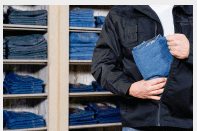 Using Facebook, their own websites and other social media outlets, many retailers have for years posted pictures of shoplifters on line in hopes of catching the shoplifter. Posting images and descriptions of suspected shoplifters can be helpful in apprehending them, but it can also be legally harmful to you and to the business if you don’t know the laws in your state regarding shoplifting laws, and you post the wrong images and descriptions of the suspected shoplifter. If your store has an LP program or department, you need to check with them before any pictures are posted on social media. And do you have insurance that will cover you in a potential law suit? Are the shoplifters juveniles? From the time you apprehend a shoplifter till the time you charge them with shoplifting, there are rules you must follow. Check the laws in your state, a lawyer, or the legal department in your store before posting any images on line.
Using Facebook, their own websites and other social media outlets, many retailers have for years posted pictures of shoplifters on line in hopes of catching the shoplifter. Posting images and descriptions of suspected shoplifters can be helpful in apprehending them, but it can also be legally harmful to you and to the business if you don’t know the laws in your state regarding shoplifting laws, and you post the wrong images and descriptions of the suspected shoplifter. If your store has an LP program or department, you need to check with them before any pictures are posted on social media. And do you have insurance that will cover you in a potential law suit? Are the shoplifters juveniles? From the time you apprehend a shoplifter till the time you charge them with shoplifting, there are rules you must follow. Check the laws in your state, a lawyer, or the legal department in your store before posting any images on line.
For more about this and other stories, follow the links below.
Local business uses Facebook to catch shoplifting suspect
A small business in Olive Branch is fighting back against shoplifters by using social media.
If the Pink Coconut Boutique catches you stealing, they will post you picture on Facebook. It’s a tactic they’ve always used, and it seems to be working well.
Store manager Debbie Ham recently posted a picture of an alleged shoplifter on the businesses page. She called for the 1.1 million Facebook followers to help identify the suspect.
And in less than 24 hours, 25-year-old Christian Tatum was identified.
“The fans were very upset (because) we do keep our prices down at the Pink Coconut,” Ham told FOX13.
This is not the first time the store has done it. They use the practice to help keep prices low.
Police would not comment on the matter. They only said it was the Facebook post that led to Tatum being identified.
“We do have 30 cameras in our store that we are very quick (to use). If there is an incident, we take our camera and review our video and burn a CD and we also post it to social media,” Ham said.
With millions of Facebook fans, the post led the Pink Coconut getting swamped with people reporting the accused criminal.
Detention and arrest of person suspected of larceny of goods held for sale.
(a) A peace officer, a merchant or a merchant’s employee who has probable cause for believing that goods held for sale by the merchant have been unlawfully taken by a person and that he can recover them by taking the person into custody may, for the purpose of attempting to effect such recovery, take the person into custody and detain him in a reasonable manner for a reasonable length of time. Such taking into custody and detention by a peace officer, merchant or merchant’s employee shall not render such police officer, merchant or merchant’s employee criminally or civilly liable for false arrest, false imprisonment or unlawful detention.
(b) Any peace officer may arrest without warrant any person he has probable cause for believing has committed larceny in retail or wholesale establishments.
Kohl’s shoplifters identified after public’s response to released photos
D’IBERVILLE — A surveillance picture released to the media has helped lead to the identity of two women accused of shoplifting and assaulting a Kohl’s employee, police said.
Police obtained arrest warrants for Michelle Quin and Tykeshia Barnes, both 18, and released their names Monday.
Deputy Police Chief Clay Jones said a third woman who appeared in the surveillance picture was not arrested.
Quin and Barnes each face charges of shoplifting and simple assault.
Police said the store on Promenade Parkway had reported the women stole merchandise Jan. 8 and said two of the them assaulted a loss-prevention officer who tried to get them to return inside the store.

 With January the last month fiscal month for plenty of retailers, we can all look forward to *drum roll* INVENTORIES!! Wait, am I the only one excited to count millions of pieces of merchandise in a single night? I’ve always been the odd-ball in my department I guess. Inventory is a great way to start a new fiscal year off. Clean inventory counts, accurate pricing and getting back in stock is the key to making sales in the 1
With January the last month fiscal month for plenty of retailers, we can all look forward to *drum roll* INVENTORIES!! Wait, am I the only one excited to count millions of pieces of merchandise in a single night? I’ve always been the odd-ball in my department I guess. Inventory is a great way to start a new fiscal year off. Clean inventory counts, accurate pricing and getting back in stock is the key to making sales in the 1 I’m seeing a huge spike in return fraud, so I’m betting you are too. For my particular stores, it is a huge problem. I will venture to say that it is the biggest and most financially impactful fraud scheme that is affecting my stores; and it’s only getting bigger. I’m fortunate enough to have a small team within our LP department that do nothing but review returns data. When they see something that is indicative of fraud, we actually cancel the store credits unless proof of purchase can be verified. We are poised to break 5 million dollars in suspended store credits this year. Insane.
I’m seeing a huge spike in return fraud, so I’m betting you are too. For my particular stores, it is a huge problem. I will venture to say that it is the biggest and most financially impactful fraud scheme that is affecting my stores; and it’s only getting bigger. I’m fortunate enough to have a small team within our LP department that do nothing but review returns data. When they see something that is indicative of fraud, we actually cancel the store credits unless proof of purchase can be verified. We are poised to break 5 million dollars in suspended store credits this year. Insane. The holidays are over and all over the country retail personnel are saying, “I can’t do that again. I’ve got to get out of retail.” Some of them are, understandably, experiencing a momentary stress or anxiety reaction. After they’ve had some time to de-stress they’ll bounce back and want to stay in the field.
The holidays are over and all over the country retail personnel are saying, “I can’t do that again. I’ve got to get out of retail.” Some of them are, understandably, experiencing a momentary stress or anxiety reaction. After they’ve had some time to de-stress they’ll bounce back and want to stay in the field.



